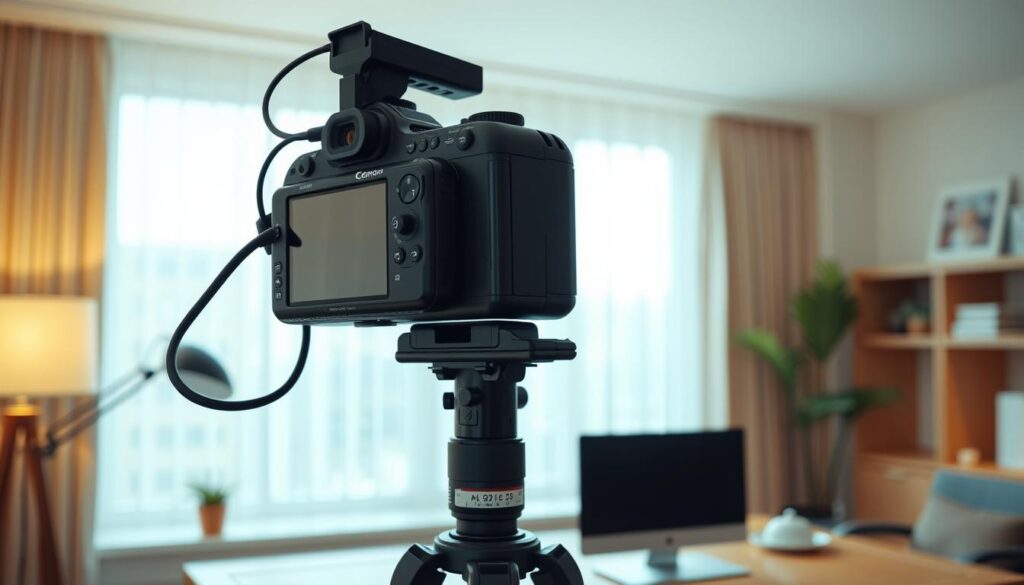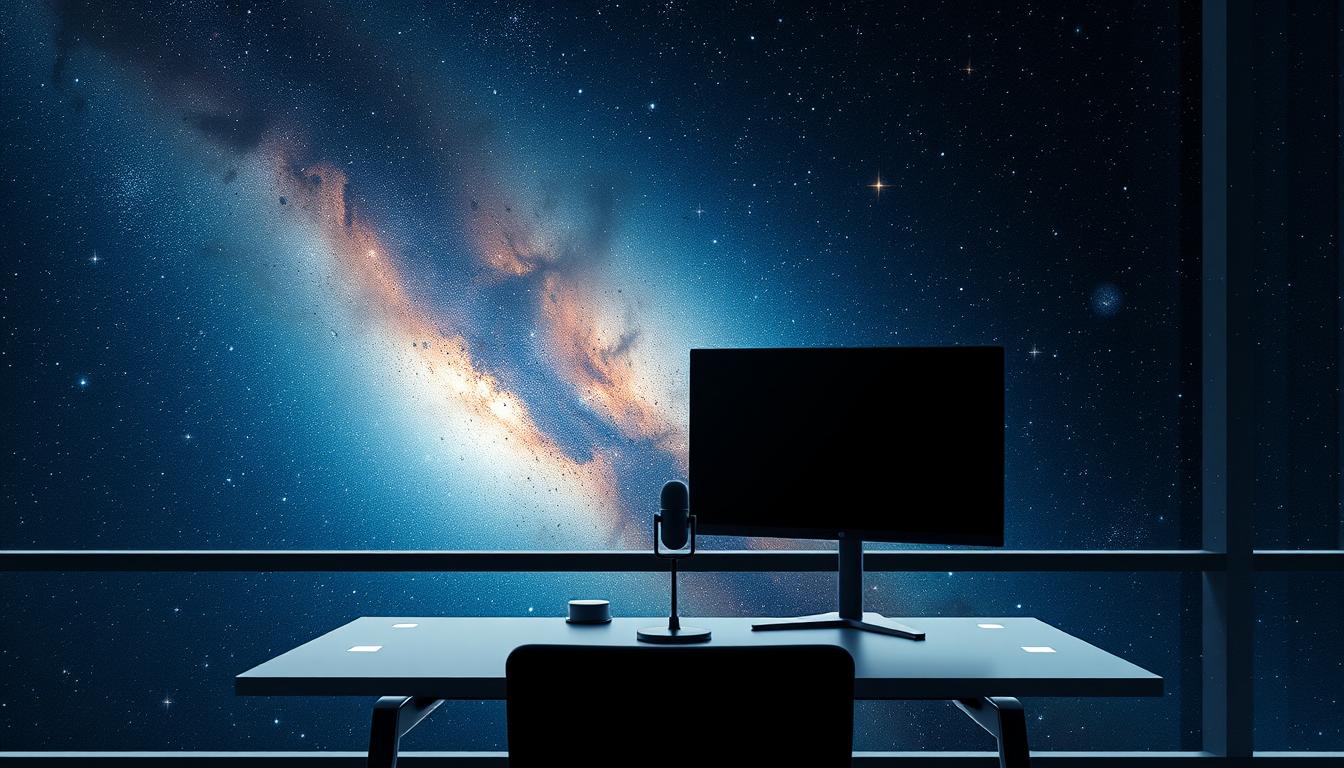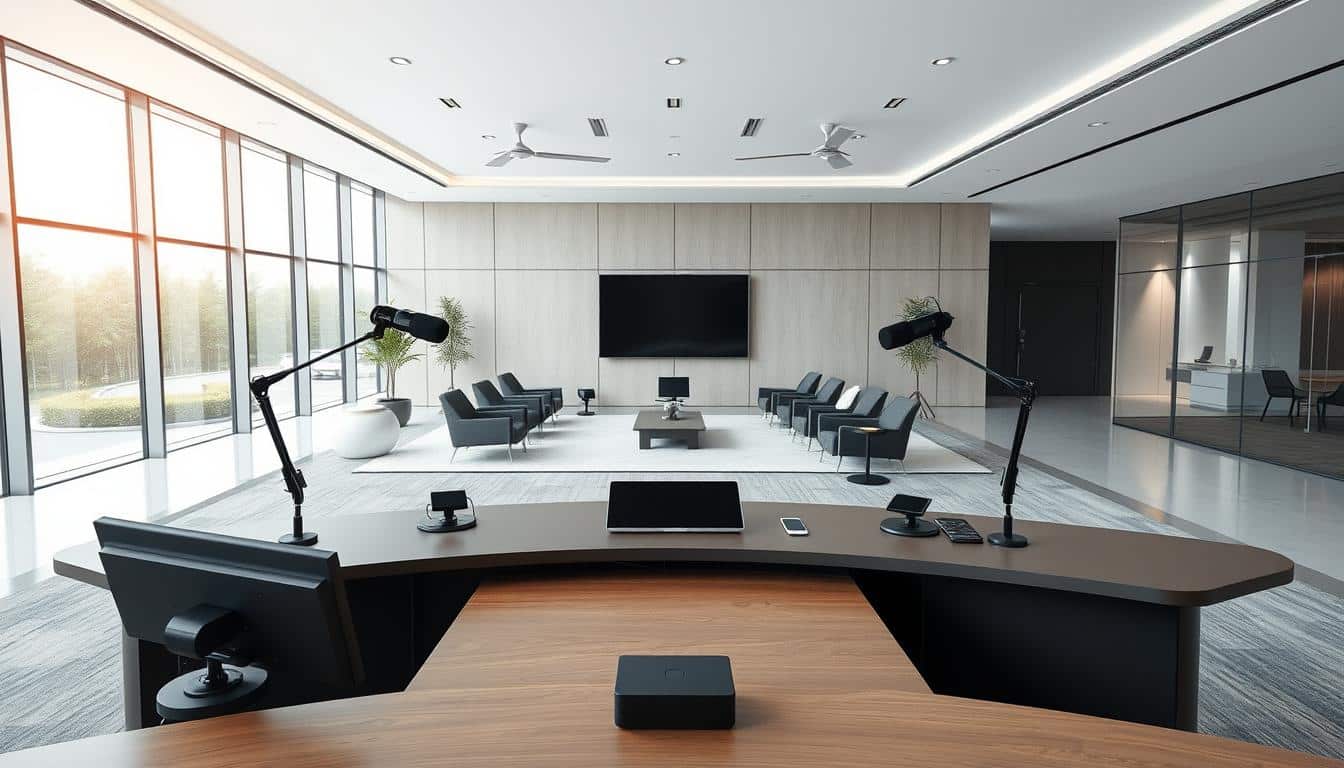Video conferencing is key in today’s communication. Knowing the best practices for virtual backgrounds is vital. The right background helps keep focus and sets the tone for meetings. It’s important in remote work to have a clear background. This keeps things professional and keeps your home life private.
Good lighting can make your virtual background look sharp. Adding a plant or artwork can make it personal but not distracting. Always check your setup before a call to avoid any issues.
Anúncios
The Importance of Virtual Backgrounds in Video Calls
Virtual backgrounds in video calls are very important. They help shape how we’re seen in online meetings and are key to a successful video call. Having a neat virtual setting shows we are professional. This shows we care and are fully engaged when talking to colleagues.
Using virtual backgrounds keeps things professional by making a space that helps us focus. Since the pandemic started, the use of video conferencing tools jumped by 500%. Having the right background helps keep people’s focus on what’s being said, not on what’s happening behind you.
Backgrounds do more than just look good. They can include your company’s logo or colors and personal images. This makes your brand more recognizable with each call. Having a uniform look helps show off your team’s identity. It builds trust and loyalty. Plus, using branded backgrounds is a smart, budget-friendly way to show professionalism.
Tools like the VIDIZMO Content Creation Tool allow for even cooler background options. You can add your name, job title, and QR codes. This makes sharing your digital business card super easy. It helps with networking and communication. All these details highlight how critical virtual backgrounds are in today’s video call world.
The Benefits of Effective Virtual Backgrounds
Nowadays, 28.2% of workers blend office and home work, while 12.7% work entirely from home. Virtual backgrounds have become key in these setups. They look good and make video calls seem more professional. These backgrounds keep our private lives out of view, ensuring we stay focused on work topics.
Companies use virtual backgrounds to show off their brand. They can add logos or colors that match their brand’s look. This helps clients remember them better, linking what they see to the company.
Choosing the right virtual background doesn’t cost much but makes a big difference. It makes the meeting look more professional and fits with most video software.
Using HD virtual backgrounds improves how professional you look. For the best quality, try using a green screen or a plain backdrop. Test your backgrounds before meetings to make sure they look right and match your branding style.
Choosing the Right Virtual Background
When picking a virtual background, think about the meeting’s vibe. Formal meetings need simple, neutral scenes. On the other hand, casual chats let you show off your creativity. Finding the right mix can make your calls more engaging and professional.
Be mindful of how background colors look with you. If you wear light colors, avoid backgrounds that match too closely. You might blend in. Do a test run by recording yourself. This way, you can see if your background fits well with how you move and look.
Choose backgrounds that keep things simple. A slight gradient or blur keeps it professional without distracting viewers. Keeping your space tidy will also help present a polished image in your meetings.
Virtual Background Best Practices
Picking the right virtual background makes your video calls better. Using solid color backgrounds makes you look more professional and cuts down on distractions. It’s important to think about the color of your background and how your clothes match with it.
Solid Color Choices for Backgrounds
Solid color backgrounds make your video calls less distracting. Choose neutral colors that fit your brand or style. Stay away from patterns or designs that could pull attention from the conversation. Make sure your background is clear by using a resolution of at least 1280×720 pixels and a 16:9 aspect ratio. This keeps your video looking good and professional.
Matching Backgrounds with Attire
Choosing what to wear is key for looking good on video. Pick clothes that go well with your background. Dressing right makes you appear more professional and helps your background to enhance, not compete with, your look. Paying attention to this detail improves your impact in any setting, be it work or school.
Lighting Techniques for Virtual Backgrounds
Good lighting is key for looking sharp in video calls. It makes your virtual background look clear and engaging. Choosing the right lighting can greatly improve how your video looks.
Three-Point Lighting Setup
Using a three-point lighting setup makes a big difference. It uses a key light, fill light, and backlight. The key light shines on you directly. The fill light reduces shadows from the key light. The backlight helps you stand out from your background. This setup cuts down on shadows for a nicer look.
Avoiding Backlighting Issues
Backlighting can make you look like a dark outline. To fix this, have lights shine on you from the front. Use natural window light or LED ring lights. Make sure your lighting is even in your video. Check your lighting with tools like Photo Booth before your calls. Using soft lights or light diffusers can make your video look better.
Camera Positioning for Optimal Presentation
Putting your camera in the right spot is key for looking professional on video calls. To get the best view, place your camera at eye level or a bit higher. This stops odd angles and keeps people watching interested. Don’t make the mistake of having your camera too close to a wall or set too low, as it can ruin the look of your presentation.
Using the rule of thirds makes your shot look better. Place your eyes on the top third line of the screen. If you’re sitting, your chin should be in view from your mid-chest, with a little space above your head. While standing, show your elbows and leave space above your head. Stay about an arm’s length away from the camera to frame your face and upper body well.
To keep your camera steady, think about using a tripod or a laptop stand. The right camera height stops bad angles and makes your video feel more natural and engaging. Also, check your camera and lighting before your meetings to make sure everything looks good.
Use soft, diffused light by being near a window or using a ring light. This avoids harsh shadows and makes everything clearer. Make sure your background is simple and not busy, so people focus on you, not what’s behind you. With good camera placement and these tips, your video calls will look more professional.

Common Mistakes to Avoid with Virtual Backgrounds
Looking professional on video calls means picking the right virtual backgrounds. Many people make mistakes that lower their presentations’ quality. Knowing what to avoid with virtual backgrounds makes your communication clearer.
Avoiding Messy or Distracting Backgrounds
A busy or cluttered virtual background can distract from what you’re saying. A chaotic background takes the focus off your words. Choose simple and neat backgrounds that match your style instead. Using low-quality images can also make your background look bad.
Not Using a Green Screen When Necessary
Using a green screen improves your video calls. Without one, your background might not look right. Bad lighting and poor equipment can make you seem unprofessional. For serious presentations, not using a green screen can hurt your chance to look authentic.
Tips for Enhancing Virtual Backgrounds
Improving your virtual backgrounds makes your video calls look more professional. A great tip is to use a solid color, like green. Green is rare in daily life, making it easy for apps like Zoom to change your background smoothly.
Good lighting is key, too. Try using lights at 45-degree angles from your camera. This method helps you get rid of shadows, making your video look cleaner.
It’s important to stand 5-7 feet away from your background to avoid unwanted effects. Using several lights helps keep shadows under control, for a clearer view. But, try to stay away from ring lights as they can create shadows right behind you, which isn’t good for your video’s look.
Choosing a professional-looking background says a lot about you. Business pros often pick neutral backdrops or plain walls. Adding things like logos or custom designs can make it even better, showing off your brand in a subtle way.
Lighting is crucial for making your background look its best. Stay away from lights behind you and go for LED lights or a two-point lighting setup. A green screen can stop those annoying visual issues, making your background clear. Make sure you stand out against your background for the best effect. Adding soft gradients can also make it look more professional.
Finally, being consistent with your virtual backgrounds helps send a clear message about your brand. It makes your team’s presentations look united, giving a better visual experience in every video call.
Conclusion
Choosing the right virtual backgrounds can greatly improve your video calls and make you look more professional. The key points include picking the right scene, good lighting, and the best camera angle. These steps help make you more productive and communicate better.
Virtual backgrounds change how we join in meetings, parties, and classes. Matching your background to your call’s aim helps show off your personal or company brand. You can use tools like Spreadly or create your own in Canva. This makes it easy and creative.
Knowing how to use virtual backgrounds well keeps you looking professional on calls. Take care of the technical stuff and remember call manners. This helps make the conversation better. Since video chats are a big part of our lives, getting your virtual background right is worth it.
FAQ
What factors should I consider when choosing a virtual background?
How can I improve the professionalism of my virtual background?
Why is lighting important for virtual backgrounds?
What are some common mistakes to avoid with virtual backgrounds?
How can I enhance the quality of my video calls?
What type of backgrounds are best for video calls with clients?
Conteúdo criado com auxílio de Inteligência Artificial



